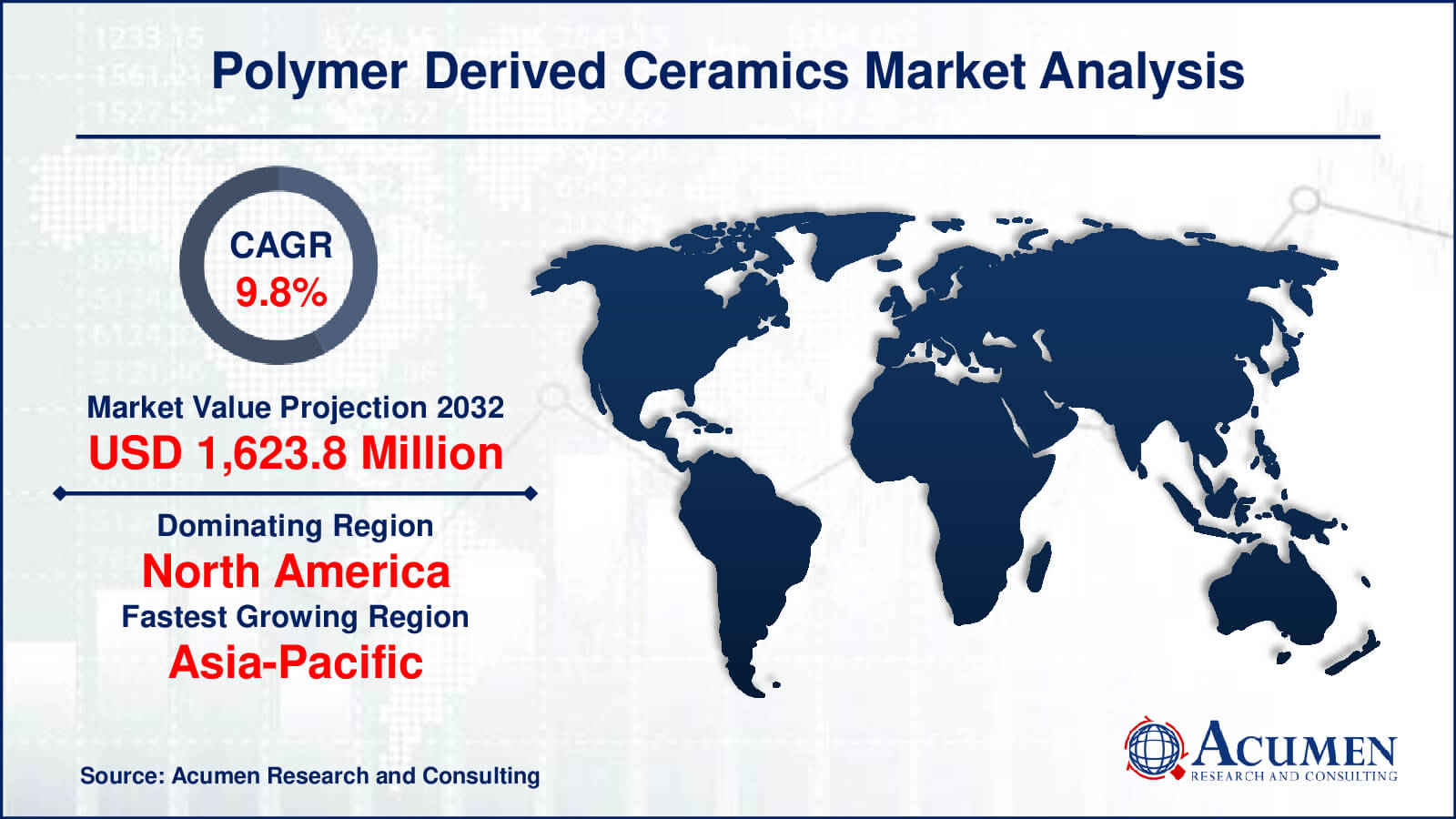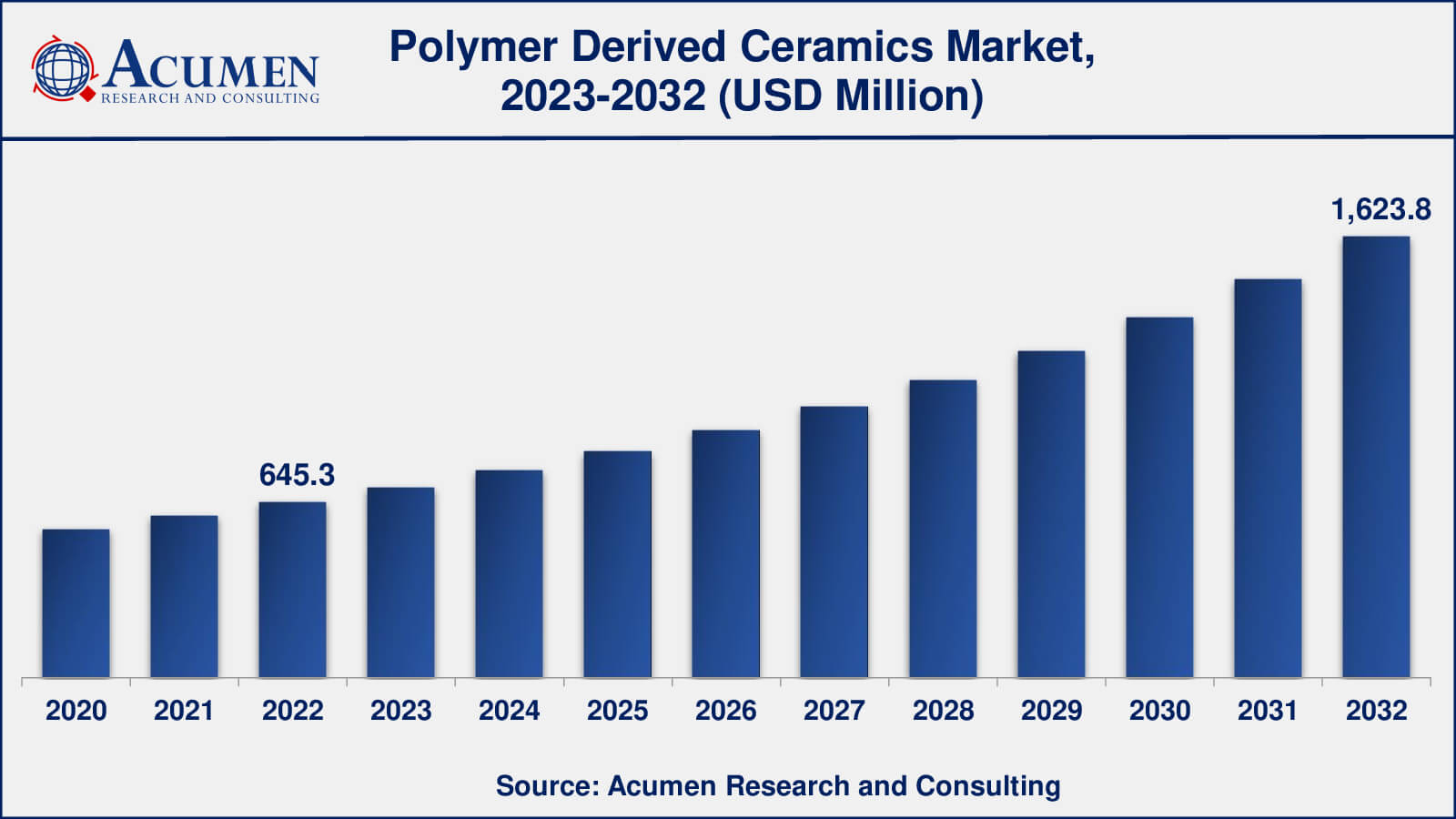November 2022
Polymer Derived Ceramics Market gathered USD 645.3 Million in 2022 and is expected to reach USD 1,623.8 Million by 2032, growing at a CAGR of 9.8% from 2023 to 2032.
The global Polymer Derived Ceramics Market gathered USD 645.3 Million in 2022 and is expected to reach USD 1,623.8 Million by 2032, growing at a CAGR of 9.8% from 2023 to 2032.
Polymer Derived Ceramics Market Highlights

Polymer-derived ceramics are a transformative technique used to prepare various ceramic materials, including ceramic matrix composites, fibers, bulk materials, coatings, and more. The process of converting polymers into ceramics has enabled significant technological advancements in ceramic technology. These advancements include the improvement and development of ceramic coatings, ceramics that remain stable or maintain their integrity as fibers at ultrahigh temperatures, addressing issues related to phase separation, crystallization, decomposition, and creep.
Numerous critical breakthroughs have been achieved, such as the discovery of diverse functional properties associated with polymer-derived ceramics.

Global Polymer Derived Ceramics Market Dynamics
Market Drivers
Market Restraints
Market Opportunities
Polymer Derived Ceramics Market Report Coverage
| Market | Polymer Derived Ceramics Market |
| Polymer Derived Ceramics Market Size 2022 | USD 645.3 Million |
| Polymer Derived Ceramics Market Forecast 2032 | USD 1,623.8 Million |
| Polymer Derived Ceramics Market CAGR During 2023 - 2032 | 9.8% |
| Polymer Derived Ceramics Market Analysis Period | 2020 - 2032 |
| Polymer Derived Ceramics Market Base Year |
2022 |
| Polymer Derived Ceramics Market Forecast Data | 2023 - 2032 |
| Segments Covered | By Product Type, By Application, And By Geography |
| Regional Scope | North America, Europe, Asia Pacific, Latin America, and Middle East & Africa |
| Key Companies Profiled | COI Ceramics, Inc., Morgan Advanced Materials, UBE Industries, Ltd., CeramTec GmbH, Ceramaret SA, Lancer Systems, Ceramic Substrates & Components Ltd, Starfire Systems, Inc., Harrop Industries, Inc., and Rauschert GmbH. |
| Report Coverage |
Market Trends, Drivers, Restraints, Competitive Analysis, Player Profiling, Covid-19 Analysis, Regulation Analysis |
Polymer Derived Ceramics Market Insights
The polymer-derived ceramics market exhibits dynamic characteristics shaped by a variety of factors. One prominent driver in polymer-derived ceramics market is the increasing demand for high-temperature-resistant materials. Industries such as aerospace and automotive are continually seeking advanced ceramics capable of withstanding extreme conditions. As a result, the polymer-derived ceramics sector has witnessed substantial growth due to its ability to provide materials that maintain their integrity at ultrahigh temperatures.
However, the market faces notable restraints, including the complexity and costliness of production processes. The transformation of polymers into ceramics involves intricate procedures, and this can lead to higher manufacturing expenses. Additionally, limited awareness and adoption of polymer-derived ceramics in some industries pose challenges to market growth. Moreover, environmental concerns related to the precursor materials used in the conversion process necessitate careful consideration and sustainable practices.
Despite these challenges, numerous opportunities beckon in the polymer-derived ceramics market. Emerging applications in industries such as energy and electronics offer significant growth potential. Researchers are continually exploring novel applications, and there is a growing interest in developing sustainable and eco-friendly variants of polymer-derived ceramics. Collaborative efforts among industry players are also contributing to process optimization and cost reduction, opening doors for market expansion.
In summary, the polymer-derived ceramics market operates within a dynamic framework characterized by a balance of drivers, restraints, and opportunities. As technology advances and industries seek materials capable of withstanding extreme conditions, this market is expected to continue evolving to meet the demands of diverse applications across various sectors.
Polymer Derived Ceramics Market Segmentation
The worldwide market for polymer derived ceramics is split based on product type, application, and geography.
Polymer Derived Ceramics Product Types
According to the polymer derived ceramics indutry analysis, silicon carbide (SiC) fibers were one of the dominant product types in the polymer derived ceramics market. SiC fibers are known for their exceptional properties, including high-temperature resistance and mechanical strength. These properties make SiC fibers highly desirable in various industries, including aerospace, automotive, and electronics, where advanced ceramics are required for demanding applications.
However, the others category typically includes a range of different ceramic materials and products within the polymer derived ceramics market. The dominance of SiC fibers may vary depending on the specific applications and market trends. To get the most up-to-date information on the dominant product type in the polymer derived ceramics market, I recommend referring to the latest industry reports or market research studies, as market dynamics can change over time.
Polymer Derived Ceramics Applications
As per the polymer derived ceramics market forecast, the aerospace industry is one of the prominent applications that is expected to dominate the polymer derived ceramics market. Aerospace applications often require advanced materials with high-temperature resistance, excellent mechanical properties, and durability. Polymer-derived ceramics, such as Silicon Carbide (SiC) and other advanced ceramic materials, have found extensive use in aerospace components like aircraft engine parts, heat shields, and various structural components due to their ability to meet these stringent requirements.
Polymer Derived Ceramics Market Regional Segmentation
North America
Europe
Asia-Pacific
Latin America
The Middle East & Africa
Polymer Derived Ceramics Market Regional Analysis
North America is a significant player in this market, driven by robust demand from industries like aerospace, defense, and electronics. The United States, in particular, is a major contributor to the market due to its advanced technology infrastructure and substantial investments in research and development.
Europe also holds a substantial share in the polymer derived ceramics market, with countries like Germany, France, and the United Kingdom at the forefront. The European market benefits from a strong presence of aerospace and automotive industries that rely on advanced ceramic materials.
Asia-Pacific has emerged as a rapidly growing region in the polymer derived ceramics market. Countries like China, Japan, and South Korea are witnessing increased adoption of these ceramics in various industries, including electronics and energy. The region's expanding manufacturing capabilities and rising technological expertise contribute to market growth.
Polymer Derived Ceramics Market Players
Some of the top polymer derived ceramics companies offered in our report includes COI Ceramics, Inc., Morgan Advanced Materials, UBE Industries, Ltd., CeramTec GmbH, Ceramaret SA, Lancer Systems, Ceramic Substrates & Components Ltd, Starfire Systems, Inc., Harrop Industries, Inc., and Rauschert GmbH.
Looking for discounts, bulk pricing, or custom solutions? Contact us today at sales@acumenresearchandconsulting.com
November 2022
March 2023
October 2018
September 2024